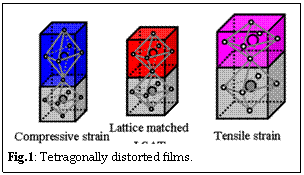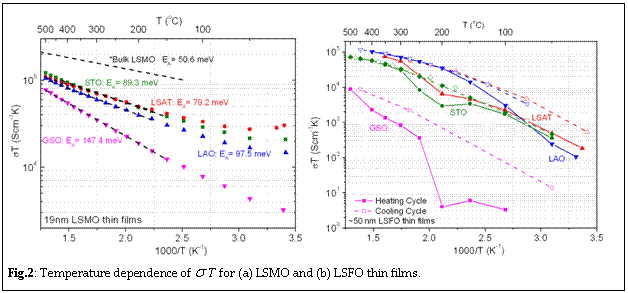AmericanChemicalSociety.com
Reports: G5 48308-G5: Superlattices of Perovskite Structured Materials for Solid Oxide Fuel Cells
Yayoi Takamura, University of California (Davis)
This proposal aims to gain an understanding of surface and interfacial phenomena in thin films and superlattices of perovskite structured materials for improved performance of intermediate temperature solid oxide fuel cells (IT-SOFC's). Perovskite structured materials are chosen for the possibility of tuning their properties through chemical and structural parameters and the ability to meet stringent requirements associated with the operation of SOFC's. La1-xSrxMO3 is the material of choice for high temperature cathode materials, however, the lack of oxygen vacancies leads to nearly exclusive electronic conduction and unacceptable performance at intermediate temperatures. In response, La1-xSrxMO3 with transition metal cations (M=Fe, Co, and Ni) are investigated for mixed ionic and electronic conductivity, catalytic activity, and bulk diffusion.
The development of micro- and IT-SOFC's necessitates the use of thin film electrodes and electrolytes to minimize overall cell resistivity. These thin films experience strains which arise during processing and during operation due to factors such as thermal expansion coefficient differences. To understand real time performance of these SOFC's, one must understand the strain effect on parameters such as conductivity, mechanical properties, and materials compatibility. We utilize epitaxial thin films grown on various single crystal oxide substrates as a model system to systematically vary the amount and type of strain imposed on thin film cathode materials, La0.67Sr0.33MnO3 (LSMO) and La0.7Sr0.3FeO3 (LSFO).
Table SEQ Table \* ROMAN I: Structural parameters of LSMO films
Substrate
| Thickness(Å)
| A(Å)
| c(Å)
| c/a
| Strain state
| EA(meV) |
LAO
| 190
| 3.849
| 3.890
| 1.011
| Partially relaxed– compressive
| 97.5
|
LSAT
| 190
| 3.876
| 3.881
| 1.001
| Lattice matched
| 79.2
|
STO
| 190
| 3.905
| 3.859
| 0.988
| Fully strained–tensile
| 89.3
|
GSO
| 190
| 3.905
| 3.836
| 0.982
| Mixed–relaxed–tensile
| 147.4
|
3.973
| 3.836
| 0.966
| Mixed–strained–tensile
|
Table SEQ Table \* ROMAN II: Structural parameters of LSFO films.
Substrate
| Thickness(Å)
| a(Å)
| c(Å)
| c/a
| Strain state
| c(Å)after
|
LSAT
| 566
| 3.868
| 3.946
| 1.020
| Fully strained–comp.
| 3.956
|
LAO
| 500
| 3.902
| 3.917
| 1.004
| Relaxed
| 3.925
|
STO
| 400
| 3.905
| 3.916
| 1.003
| Lattice matched
| 3.925
|
GSO
| 470
| 3.966
| 3.858
| 0.973
| Fully strained-tensile
| 3.879
|
|
Fig.1: Tetragonally distorted films.
|

In bulk, LSMO has a rhombohedral perovskite structure which can be approximated as pseudocubic (a=3.873Å), while LSFO is orthorhombic (a=5.501Å, b=5.544Å, and c=7.846Å). Thin films were grown by pulsed laser deposition on single crystal oxide substrates including (001)-oriented (LaAlO3)0.3(Sr2AlTaO6)0.7 (LSAT, cubic, a=3.868Å), SrTiO3 (STO, cubic, a=3.905Å), LaAlO3 (LAO, pseudocubic, a=3.788Å), and (110)-oriented GdScO3 (GSO, orthorhombic, a=5.488Å, b=5.746Å, c=7.934Å). The substrate temperature was 700ºC and chamber pressure was 500mTorr O2. The samples were cooled in 300Torr O2 to ensure the proper oxygen stoichiometry. The lattice mismatch between LSMO/LSFO and these substrates ranged from -2.16%/3.09% (LAO) to 2.51%/1.71%. For small lattice mismatch, fully strained films assume the in-plane lattice parameter, a, of the substrate, while the out-of-plane lattice parameter, c, freely contracts (tensile strain) or expands (compressive strain), depending on whether the substrate lattice parameter is larger or smaller than the film, respectively (Fig.1). In contrast, fully relaxed films retain their bulk lattice parameters as the film cannot support the strains associated with large lattice mismatch. Partially relaxed films lie somewhere in between, while a mixed state results when the film close to the substrate is fully strained and the remainder is partially or fully relaxed. The structural properties were determined by x-ray diffraction (XRD) and are summarized in Tables I and II. The amount of strain, characterized by the tetragonal distortion, c/a ratio, varies over a large range by the substrate choice.
Figure 2 plots
![]() T vs. 1000/T for LSMO and LSFO thin films grown on
various substrates for temperatures from 20-500ºC in air. For small polaron
hopping, the conductivity,
T vs. 1000/T for LSMO and LSFO thin films grown on
various substrates for temperatures from 20-500ºC in air. For small polaron
hopping, the conductivity,
![]() , can be expressed as:
, can be expressed as:
![]() where A is a
pre-exponential factor and EA is
the activation energy. For LSMO films,
where A is a
pre-exponential factor and EA is
the activation energy. For LSMO films,
![]() T curves fall
on a straight line for temperatures >150ºC suggesting that conduction occurs by small polaron hopping. At lower temperatures, the film transitions
to a metallic ferromagnetic phase at the Curie temperature. These measurements
are repeatable for multiple temperature cycles. With increasing strain,
T curves fall
on a straight line for temperatures >150ºC suggesting that conduction occurs by small polaron hopping. At lower temperatures, the film transitions
to a metallic ferromagnetic phase at the Curie temperature. These measurements
are repeatable for multiple temperature cycles. With increasing strain,
![]() T decreases
monotonically while EA
increases. These values differ from reported literature values for bulk samples
such that on GSO, EA is ~3X
larger and sT is ~10X lower at 150ºC. This trend is attributed
to the distortion of MnO6 octahedra in the
perovskite structure in terms of bond angles and bond distances.
T decreases
monotonically while EA
increases. These values differ from reported literature values for bulk samples
such that on GSO, EA is ~3X
larger and sT is ~10X lower at 150ºC. This trend is attributed
to the distortion of MnO6 octahedra in the
perovskite structure in terms of bond angles and bond distances.
For LSFO films, the same trend of decreasing
![]() T with increasing strain
is observed, however, a single EA cannot describe the entire temperature range studied
as the slope decreases at high temperatures. In addition, we observe a sharp
drop in
T with increasing strain
is observed, however, a single EA cannot describe the entire temperature range studied
as the slope decreases at high temperatures. In addition, we observe a sharp
drop in
![]() T around 200ºC for many samples. This drop
in
T around 200ºC for many samples. This drop
in
![]() >T coincides with a
jump in film out-of-plane lattice parameter which is absent for the substrate,
indicating a change in tetragonal distortion. Heating and cooling cycles display
differing behavior: upon cooling the sharp drop in
>T coincides with a
jump in film out-of-plane lattice parameter which is absent for the substrate,
indicating a change in tetragonal distortion. Heating and cooling cycles display
differing behavior: upon cooling the sharp drop in
![]() T disappears and the
T disappears and the
![]() T value is higher
than during heating cycle. The difference in
T value is higher
than during heating cycle. The difference in
![]() T between the two cycles
increases as the strain increases. XRD
scans taken after heating/cooling cycles indicate that the out-of-plane lattice
parameter and surface roughness have increased. For LSFO on GSO, this increase
in out-of-plane lattice parameter could correspond to strain relaxation,
however, one would expect a decrease
in out-of-plane lattice parameter upon relaxation for LSFO on LSAT, and no
relaxation for relaxed and lattice matched films on LAO and STO, respectively. Instead,
this change could result from an alteration of the concentration of oxygen
vacancies. Further analysis in varying ambient (N2, pure O2)
and differential scanning calorimetry and/or thermogravimetric analysis may clarify the origin of this
effect.
T between the two cycles
increases as the strain increases. XRD
scans taken after heating/cooling cycles indicate that the out-of-plane lattice
parameter and surface roughness have increased. For LSFO on GSO, this increase
in out-of-plane lattice parameter could correspond to strain relaxation,
however, one would expect a decrease
in out-of-plane lattice parameter upon relaxation for LSFO on LSAT, and no
relaxation for relaxed and lattice matched films on LAO and STO, respectively. Instead,
this change could result from an alteration of the concentration of oxygen
vacancies. Further analysis in varying ambient (N2, pure O2)
and differential scanning calorimetry and/or thermogravimetric analysis may clarify the origin of this
effect.
These results highlight the importance of understanding
the effect of lattice strain on the conductivity of thin film cathode
materials. With increasing strain,
![]()
![]()
| Fig.2: Temperature dependence of T for (a) LSMO and (b) LSFO thin films.
|

Copyright © American Chemical Society

